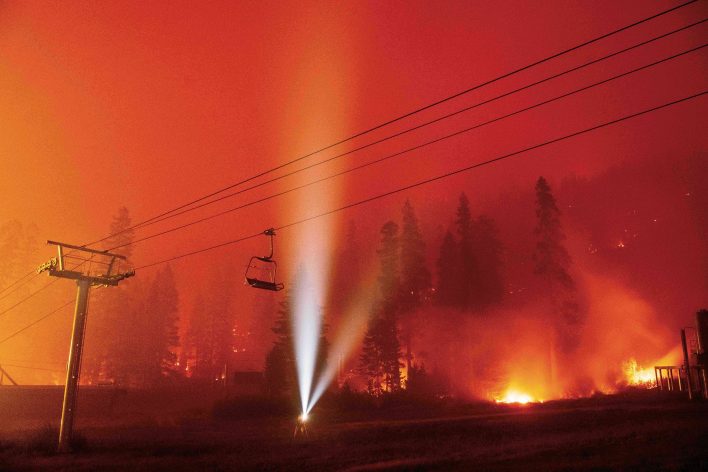
THE DIXIE FIRE HAD BEEN raging for weeks, engulfing towns and scorching huge swathes of forest.
Hotshot firefighter Garrett Balen had barely had a day off all summer when his crew was deployed to an area between the small northern California towns of Taylorsville and Quincy.
It was August 2021, and the Dixie—which started as two fires before merging into one behemoth—was rapidly becoming one of the largest blazes in California history, spanning five counties, extending from Plumas National Forest north toward Lassen Volcanic National Park and eventually burning nearly 1 million acres. The fire started in July, when a tree fell onto a power line in the Feather River Canyon, and heavy winds, high temperatures and extremely dry vegetation propelled its growth.
Balen and his crew were working a prominent ridgeline, hiking up and down a steep, 3,500-vertical-foot face that Balen describes as “total billy-goat terrain,” trying to put out a spot fire. It was so steep that when one guy stepped on a rock the wrong way, the whole slope rumbled into a landslide. The ridge had cliff bands, rock-lined chutes and wide-open gullies.
“We were in it, above it, below it,” Balen says. “The whole time we were there, I spent a lot of time looking at this terrain while it was 95 degrees out, thinking, ‘Man, it’d be cool to be skiing this.’ It’s hard to know what something would look like with snow on it, but looking at it, you could tell it would be wide open and smooth. There was no brush. It was blackened by fire. Put enough snow on it and you could just open ’er up and go fast.”
Balen, a Tahoe-based backcountry skier who grew up in Alaska, has fought fires in the summers to support his ski habit since 2014. He’s seen the fire season in the West grow longer and more intense each year—and the winters get shorter.
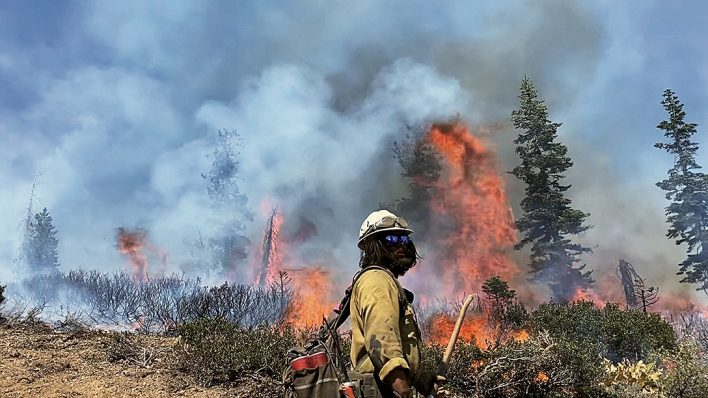
“In California, it’s so warm. If it’s not actively snowing, it’s melting,” says Balen. “The burn scars from fires are everywhere: You see these areas where everything is dead. All the trees are dead; it’s just grass and brush that have grown back. That’s what California is turning into.”
He’s not a snow scientist, but from his perspective—working on the grounds of these massive wildfires and then skiing all winter—Balen has an educated guess of what the fires are doing to the snowpack. “I think, in some ways, fires can make for better skiing, by opening zones up more,” he says. “But, at the same time, the fire takes away all the coverage and destroys the canopy.”
Logically speaking, if you burn all the limbs off trees, the snow on the ground is less protected and therefore more exposed to the elements. “Those sheltered hidden gems that people love to ski after a storm might not stay good,” he says. “I imagine if you have a slope that gets more sun and you take all the shade off, that snow will disappear faster.” He’s right. According to research, warmer temperatures and an increase in wildfires are wreaking havoc on our ecosystems. Snowpacks are warmer, snow is melting earlier, and all that has a devastating trickle-down effect on water resources and forest health. But what’s it doing for skiing? And what does a future look like for those who love snow on a planet that’s constantly up in flames?

I LEFT MY HOME in Tahoe City, California, last summer when the Dixie fire was gaining speed and the air quality was worse than that of Beijing on a bad day. The app that reports air quality was becoming the first thing I’d check on my phone in the morning. Could we go outside that day? Could I go for a trail run without harming my lungs? Could my kids play in the yard and breathe? When the answer became no for days on end, with smoke causing the air-quality index to spike into the purplish mid-200s, we packed our stuff into our campervan in early August and hit the road.
While we were gone, parked somewhere on the coast of California, the Caldor fire broke out just south of Lake Tahoe. As the crow flies, the fire was less than 40 miles from my house—and it was spreading fast. Eventually, evacuation orders extended to South Lake Tahoe, displacing tens of thousands of people, and reached up the west shore, about 10 miles from my home. President Joe Biden declared a state of emergency and released federal funding that supported local fire response efforts to protect the Lake Tahoe Basin. Before it was contained, the Caldor fire burned 222,000 acres and destroyed over a thousand structures.

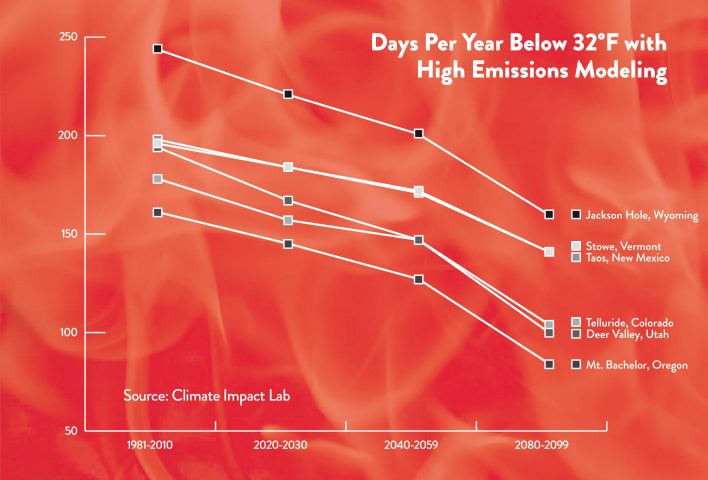
Meanwhile, the Dixie fire was raging to the north, and across the western U.S., nine other wildfires had reached more than 100,000 acres in size, making them so-called megafires, which once were rare but are now commonplace. The U.S. Forest Service used to consider wildfire season a four-month period of time, but now it’s often double that, starting early in the summer and lasting as late as November or December. Drought, warmer temperatures and forest management have all added to the increasing intensity and length of the U.S.’s fire season.
The warming climate is already drastically impacting the way we ski. Winter is becoming shorter; lower-elevation areas receive more rain and less snow; erratic storms can make snowpacks less stable and lead to more avalanche instability. In the Northeast, a report by the Climate Impact Lab estimates, 20 years from now, Stowe, Vermont, can expect a 28-percent decline in the average number of below-freezing days each year, dropping from around 28 weeks a year to under 20 weeks in a high-emissions scenario. In Tahoe, findings from the Central Sierra Snow Laboratory dating back to 1970 show increases in daily temperatures over the past five decades and an increase in precipitation, with more rain than snow.
Guides on Mt. Rainier had to shut down their climbing season weeks early in 2021 after a scorching heat wave in the Pacific Northwest melted the snowpack earlier than ever. This fall, ski resorts from Colorado to Vermont delayed opening days because they lacked enough natural snow to operate and temperatures were too warm to make snow. In places like Alaska and the Alps, glaciated terrain is thawing rapidly.
“In Greenland and Iceland, I’m seeing the snow deteriorate in early May. It’s crazy how in just 15 or 20 years, I’m seeing the differences in the seasons changing,” says polar adventurer and ski guide Doug Stoup, owner of Ice Axe Expeditions, which leads trips from Antarctica to Norway. “We’ve had to cancel trips to the Atlas Mountains in Morocco in February because there was no snow.”
Stoup sees those changes in the field, including penguins on the Antarctic Peninsula altering their feeding spots due to warmer sea temperatures and the lack of long-lasting ice on the North Pole. He often collects data in remote Arctic locations for climate scientists. “I’m not a scientist,” he says. “But I’m an observer.”
He sees the impact at his home in the Tahoe area, too, with fires and a smoke season that lingers ever longer. “It’s the whole state of California, so I’m thinking, ‘OK, should I move?’” Stoup says. “You’re dealing with the smoke, the drought. That’s a direct relation to climate change.”
Wildfires, of course, have a widespread impact on the environment. They affect everything from air quality and climate—by emitting large amounts of carbon into the atmosphere—to soil health, wildlife habitat and stormwater runoff. They have a huge effect on our livelihoods, too—hurting economies in areas shut down due to smoke or evacuations, causing respiratory issues because of air-quality concerns and burning homes and entire towns.
So, to talk about the impact of wildfires on skiers seems downright trivial. Who cares about skiing when you don’t have a home or a job or healthy forests, clean air or enough water? Well, the answer to that question is skiers. If these fires are going to impact the way we recreate in the backcountry, then we should care.
I care, anyway. Which is why, this fall, on the tail end of one of the worst fire seasons on record in the western U.S., I started calling every snow scientist I could find to ask what the hell is happening in this wacked-out inferno. Really, I asked what would happen to our snowpack as a result of these fires. But you know what I mean.
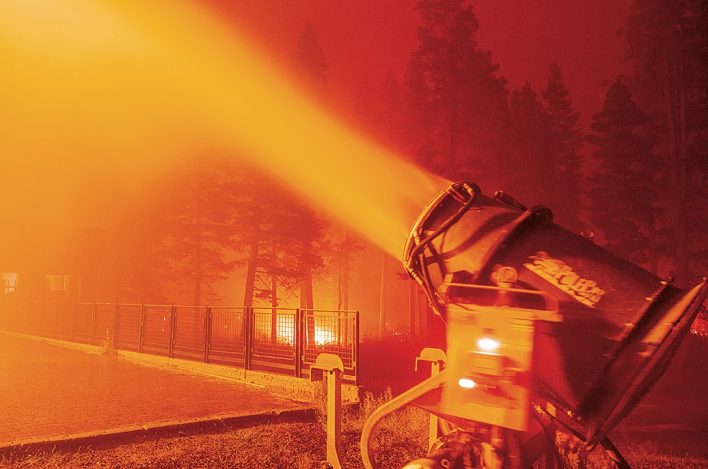
ANNE NOLIN IS A third-generation skier. Her grandmother skinned up snow-covered hills in Vermont on actual seal skins in the 1940s; her dad was a ski patroller at Mad River Glen; and she got her start at age four at Mt. Tom, a now-defunct small ski area in central Vermont. “Skiing is what we do in my family,” she says. “It’s a legacy I’d like to pass on.”
Now 63, Nolin is a renowned snow hydrologist and professor in the geography department at the University of Nevada-Reno. But she doesn’t need the data to know that climate change is already affecting winter.
“I’m a witness to climate change,” says Nolin, who started an alliance of snow and climate scientists at Protect Our Winters, an environmental advocacy group. “As skiers who spend time in the backcountry, we’re astute observers. We have valid observations. I see snow lines are higher, the snow is wetter, denser and thinner, with more rocks poking out.”
As a scientist, she has collected data to support her observations. “The last decade has seen dramatic decreases in snowpack,” Nolin says. “We have documented data that November has fewer storms, and we’re seeing statistically warmer winters across the western U.S. and earlier snowmelt in the spring.”
When she skis in the backcountry off Mt. Rose near her home in Reno, Nolin gazes into entire tree stands that have died—not from fire but from lack of water. “I see a full slope of dead trees that were alive two years ago,” she says. “Our forests are just dying from lack of moisture, from dry seasons that are much too long and hot.”
In a study published last June, Nolin and her students used computer models and satellite data to map predictions for what winter will look like in 25 years at ski areas across the country. At our current rate of warming, it’s not looking good. Traditionally cold places like Killington, Vermont, or Big Sky, Montana, will have a slightly higher rate of warmer winters, while already warm spots like Mt. Bachelor, Oregon, and Palisades Tahoe in California, will have a dramatically higher frequency of warmer winters by mid-century.
That rapid rate of snowmelt can lead to increased fire activity, too, perpetuating a vicious cycle. “In years where there’s low snowpack or it melts off early, the dry season starts earlier, lasts longer, and the forests undergo a greater degree of moisture stress,” Nolin says. “So, if we have a declining snowpack over several decades, which we’re witnessing, those lower elevations are becoming more vulnerable to fires. The fire seasons are longer, more intense, the burn severity is higher, with individual fires merging and becoming much bigger.”
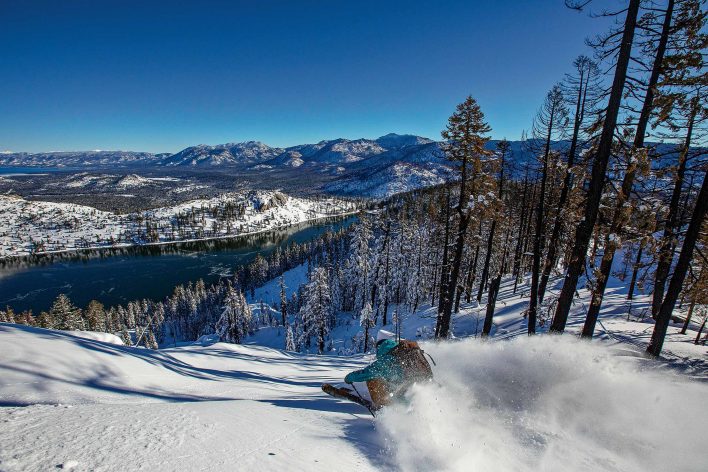
Fire can mean more wide-open glades for skiers—more visibility, more space—but what good is that if the ski season is weeks shorter? “You might have nice, open glades for skiing where there might have been dense forest before,” Nolin says. “But it’ll melt off a lot faster.”
In some cases, fire activity can lead to more snow accumulation. In December 2014, a group of students from Utah’s Brigham Young University (BYU) ski toured into the Tushar Mountains, a few hours south of Salt Lake City, to study the impact of the Twitchell Canyon fire, a lightning-caused 2010 fire that burned 45,000 acres. Their findings were clear: Areas that burned had 85 percent greater snow depth than areas that didn’t burn. They also found more water in the snow in burned areas, with a 15 percent increase in snow-water equivalent.
In simple terms, when fires burn a forest canopy, killing trees and removing branches and needles, falling snow doesn’t get caught in limbs, where it often evaporates before hitting the ground. More snow instead lands on the ground and turns to water.
“Conifer trees accumulate a lot of snow, then it transitions from snow, a solid state, to a vapor state,” says Sam St. Clair, a professor of plant ecology at BYU and co-author of the study. “The more severe the burn, the more trees you’re killing, the more snow you’re accumulating.” This depends on the slope aspect, St. Clair notes, as north-facing pitches are more shaded and hold more snow, while south-facing slopes see more sun, a fact backcountry skiers know well.
That reduced canopy also means more sun effect. “You’ve just burned off the canopy that’s shading the snowpack, so you’re letting in more sunlight,” says Nolin. “Not only have you increased the radiation, but you’ve preconditioned the snowpack to absorb that solar radiation. It’s a double whammy.” As for snowpack stability after a fire, much is still unknown. A warmer snowpack might be more stable, with more consolidated layers. But look at the burned terrain after a fire: With fewer anchors and healthy trees to prevent slides, avalanches may be more likely. “Any time you remove forest cover, you increase the probability of avalanches on steep slopes,” says Nolin.
KELLY GLEASON GREW UP skiing at Alpental, Washington, wearing a garbage bag on rainy days. Her parents would drop her off at the hill and return a few hours later. “Rain on snow is something we’ve always seen in the Northwest, but it’s happening much more than it used to even 20 years ago,” Gleason says.
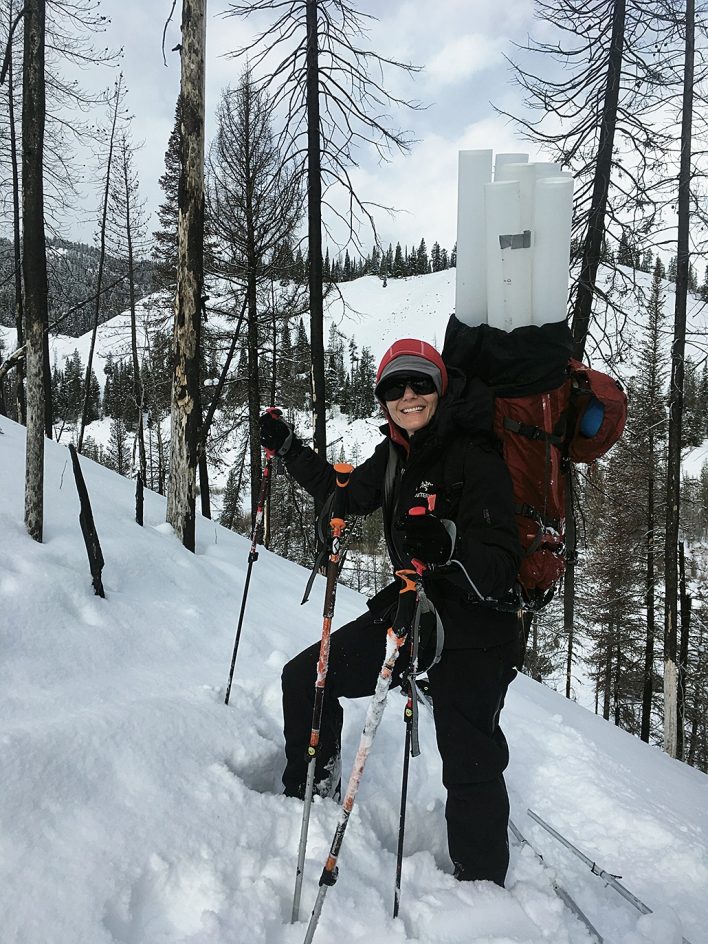
But she sees other changes, too. “The shorter seasons, I’ve really seen that in my lifetime,” she says. “I used to ski until June. Now it’s all gone by early May. Now we don’t get a good snowpack until early January, where I used to ski all of December when I was a kid.”
In 2011, Gleason was skiing near the crest of the Cascade Range in Oregon in an area burned by the B&B fire, twin blazes that collectively engulfed over 90,000 acres in 2003.
“It was a gorgeous place to be, with a clear view of all the volcanoes,” Gleason recalls. “It’s more gladed. It’s a nice place to ski.” But even years after the fire, she noticed its effects. Charred, blackened trees sloughed inky carbon and woody debris onto the snowpack, darkening the surface visibly and causing the snow to absorb more sunlight. “It’s like [wearing] a black shirt on a sunny day,” Gleason says. “You have more sunlight, then the snow is primed to absorb more sun. You get this vicious feedback of warming.”
At the time, Gleason was working on her doctorate in hydrology and geography at Oregon State University. “That’s what really started the question: Has anyone looked at how forest fires influence snow storage and snowmelt?” she wondered. “That became the focus on my research and career.” In 2013, she and her peers were the first to publish a study on the topic of quantifying the darkening effect on snow after a fire.
They studied an area burned in 2011 by the Shadow Lake fire, which scorched 10,000 acres of mixed conifer forest in the high Cascades. They found snow accumulation was greater in the burned forest, but the snowpack melted 23 days earlier. With the canopy density 60 percent more open in the burned areas, increased sunlight and darkening of the snow meant the amount of solar radiation the snow absorbed was 200 percent greater than elsewhere.
A few years later, Gleason, now an assistant professor of eco-hydro-climatology at Oregon’s Portland State University and part of the Protect Our Winters Science Alliance, published a study that found snow disappeared on average five days earlier for up to 10 years following a fire. Immediately after a fire, it can be even quicker. “Snow disappearance can occur about a month earlier the first year following a fire. That shortens our ski season, right? Which sucks,” Gleason says. “But it also has this broader watershed implication of earlier snowmelt and earlier associated downstream water availability.”
I told Gleason all this data made me want to crawl into a hole. I felt helpless, like there was nothing I could do. “I think fire is not something to fear,” she told me. “Fire is part of the natural ecosystem.”
As Gleason explained, forests were historically much less dense than they are now, and records show that if we can manage our forests properly, at lower densities, those forests can actually retain snow longer into the spring and use less water. Which is good news, something I desperately needed to hear.
“We know less dense forests hold more snow in the long run, but there are still a lot of questions,” Gleason says. “We see the fire impact on snow for about 10 years after a fire. But then after that? Maybe we can use fire as a management tool to help us retain snow longer.”
Gleason has this idea: What if she could send snow-sampling kits to backcountry skiers all over the country, to collect snow and send it to her for research? Imagine what she could do with that much data from small sampling sites from a wider variety of locations than ever studied before. She wants to increase our understanding of how black carbon from fires but also dust from overgrazing is impacting the snow. If she could look at that more broadly, she might have more answers.

EARLIER THIS WINTER, I wanted to go on a ski tour into the areas burned by the Caldor or Dixie fires. I wanted to see for myself what the snowpack looked like after those megafires had raged through just months earlier. Was the skiing better because trees had been cleared out? Was the snow deeper? Or was the sight of a blackened, scorched forest an indicator that the snowpack would be warmer, would melt sooner? The scientists had already answered many of these questions, but, still, I wanted to see it with my own eyes. I wanted to observe my surroundings as backcountry skiers do.
So, I called up Garrett Balen, the firefighter, and asked him if he’d take me to that zone he’d told me about, the ridgeline burned by the Dixie fire with the perfect pitch and the open glades. He said yes; he couldn’t wait to check out the area. We just had to wait for snow. So, we waited.
Early December came and there was still no snow around Tahoe. I kept biking and running the trails, hoping they’d soon be covered in white. The days crept on, an interminable fall. I knew winter would come. It always does. But each year, as it comes later and later, and arrives warmer and warmer, it’s hard not to overthink it. It’s hard to rest assured that everything is going to be OK. And it’s hard to know what to do to make a difference, to change the course of things for the better.
In December, Balen booked a trip to Alaska instead, not sure when he’d be back. “It’s full-on winter up there,” he told me. “I’ve got to go.” That Dixie zone, he said, would have to wait.
Megan Michelson is a freelance writer and editor based in Tahoe City, California. Her work has been featured in the New York Times, Outside, Ski and San Francisco Chronicle. Most days, you can find her skiing at Alpine Meadows with her two kids or skinning up a low-angle slope on Tahoe’s West Shore.
This story was originally published in Backcountry No. 144, The Backyard Issue. To read more of the untracked experience, pick up a copy at BackcountryMagazine.com/144 or subscribe.










Related posts: